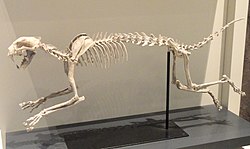Loading AI tools
Extinct genus of carnivores From Wikipedia, the free encyclopedia
Dinictis is a genus of the Nimravidae, an extinct family of feliform mammalian carnivores, also known as "false saber-toothed cats". Assigned to the subfamily Nimravinae, Dinictis was endemic to North America from the Late Eocene to Early Miocene epochs (37.2—20.4 million years ago), existing for about 16.8 million years.[1]
| Dinictis | |
|---|---|
 | |
| Skeleton from South Dakota, Royal Ontario Museum, Toronto | |
| Scientific classification | |
| Domain: | Eukaryota |
| Kingdom: | Animalia |
| Phylum: | Chordata |
| Class: | Mammalia |
| Order: | Carnivora |
| Suborder: | Feliformia |
| Family: | †Nimravidae |
| Subfamily: | †Nimravinae |
| Genus: | †Dinictis Leidy, 1854 |
| Type species | |
| †Dinictis felina Leidy, 1854 | |


Dinictis was named by American paleontologist Joseph Leidy in 1854. Its type is Dinictis felina. It was assigned to the Nimravidae by Cope (1880);[2] and to the Nimravinae by Flynn and Galiano (1982), Bryant (1991), and Martin (1998).[3][4]
In a 2016 study, the genus was found to contain only the species Dinictis felina.[5]
Dinictis had a sleek body 1.1 m (3.6 ft) long, short legs 0.6 m (2.0 ft) high with only incompletely retractable claws, powerful jaws, and a long tail. It was very similar to its close relative, Hoplophoneus. The shape of its skull is reminiscent of a felid skull rather than of the extremely short skull of the Machairodontinae. Compared with those of the more recent machairodonts, its upper canines were relatively small, but they nevertheless distinctly protruded from its mouth. Below the tips of the canines, its lower jaw spread out in the form of a lobe.
Dinictis walked plantigrade (flat-footed), unlike modern felids. Its mode of life was similar to that of a leopard. It was probably not so particular about its food as its descendants, since the reduction of its teeth was still in the early stages and Dinictis had not forgotten how to chew. In its own environment, it would have been a powerful predator.

It lived in the plains of North America with fossils found in Saskatchewan, Canada and Colorado, Montana, Nebraska, South Dakota, North Dakota, Wyoming, and Oregon in the United States. Dinictis likely evolved from an early Miacis-like ancestor that lived in the Paleocene.
Seamless Wikipedia browsing. On steroids.
Every time you click a link to Wikipedia, Wiktionary or Wikiquote in your browser's search results, it will show the modern Wikiwand interface.
Wikiwand extension is a five stars, simple, with minimum permission required to keep your browsing private, safe and transparent.